MASLD vs MetALD With Robin Soto
Chat with MASLD AI

Hi, I am MASLD AI.
Suggested Questions :

MASLD AI 04:01 AM

Robin Soto, NP, UC San Diego Health, delivers a clear, case-based overview of metabolic dysfunction–associated steatotic liver disease (MASLD), MASH, and mixed-etiology MET-ALD for the GHAPP MASLD Community Network. Using a common clinic scenario, she explains how to recognize steatotic liver disease, why getting an accurate alcohol history matters, and how non-invasive tools (e.g., FibroScan® and alcohol biomarkers) help confirm what’s driving liver injury. You’ll hear practical guidance on counseling patients—Mediterranean-style nutrition, sustainable weight loss, regular aerobic and resistance exercise, and alcohol reduction/abstinence—plus when to involve specialists and consider ongoing surveillance. Ideal for APPs and GI clinicians looking for a simple, patient-centered approach to preventing progression from fatty liver to advanced disease.
Related Podcast
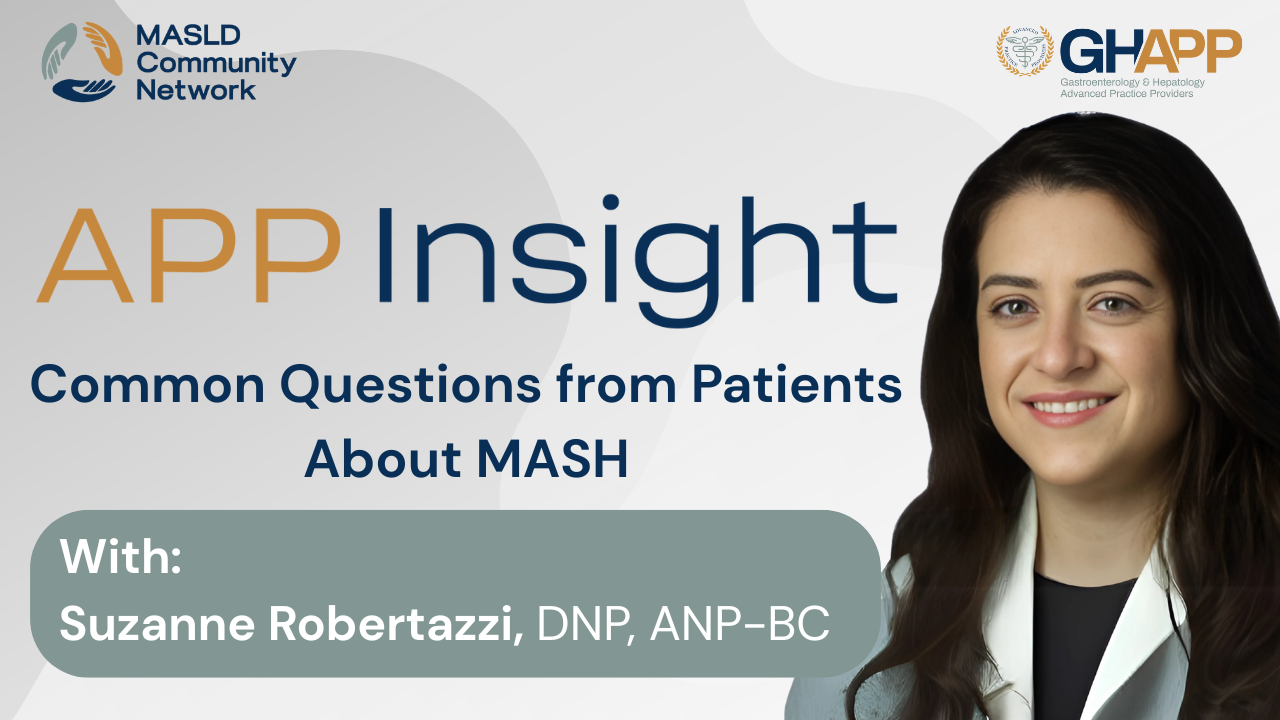
Common Questions from Patients About MASH

In this focused episode, Suzanne Robertazzi, NP at the Washington DC VA, shares expert insights on how to prevent recurrence of MASH (Metabolic-associated steatohepatitis) and MASLD (Metabolic dysfunction-associated steatotic liver disease) in liver transplant recipients. Drawing on her experience caring for post-transplant veterans, Suzanne explains that MASH can return even after liver transplantation, making ongoing metabolic management essential. She outlines key strategies including tight blood sugar and blood pressure control, especially since transplant medications can contribute to hypertension. Suzanne also emphasizes the importance of introducing regular physical activity post-recovery and adopting a Mediterranean-style diet—while tailoring nutrition guidance to meet the needs of patients in urban settings with limited access to fresh foods. This video is a must-watch for transplant teams, hepatology providers, and patients seeking to extend the life and health of their new liver through evidence-based lifestyle and clinical interventions.
Watch Now
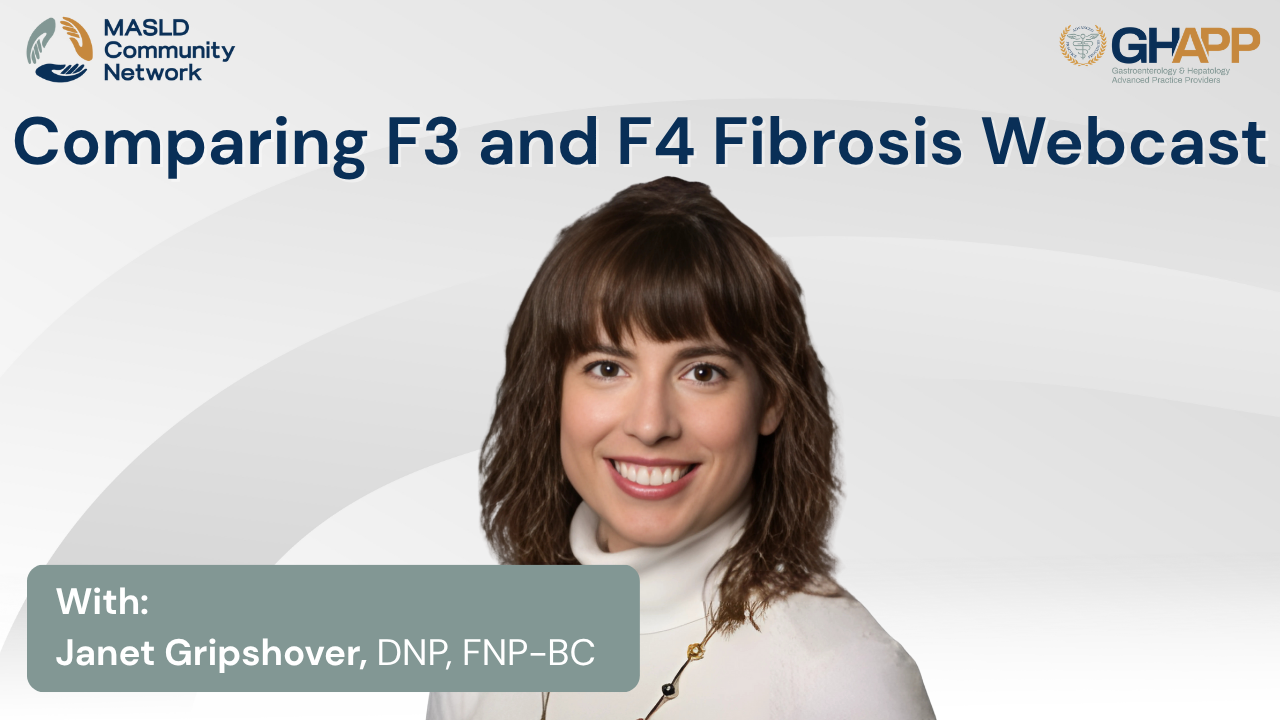
Comparing F3 and F4 Fibrosis With Janet Gripshover

Welcome to the MASLD Community Network, where experts share practical insights on diagnosing and managing metabolic dysfunction–associated steatotic liver disease (MASLD) and metabolic dysfunction–associated steatohepatitis (MASH). In this session, Janet Gripshover, NP and Nurse Manager of the Liver Transplant Program at Cedars-Sinai, explores one of the most challenging aspects of hepatology—distinguishing between F3 fibrosis and F4 cirrhosis. She explains why identifying the transition from bridging fibrosis to cirrhosis is critical for patient outcomes, treatment decisions, and cancer surveillance. Using real-world case discussions, Janet reviews non-invasive diagnostic tools such as FIB-4, transient elastography (FibroScan®), ELF testing, and lab findings, highlighting how concordant results strengthen diagnostic confidence. She also addresses risk factors like obesity, type 2 diabetes, hypertension, and sleep apnea, and emphasizes the role of lifestyle modification, GLP-1 therapies, and new treatments that can reduce fat and fibrosis progression. Importantly, she discusses why cirrhosis shifts management priorities from prevention to preservation and underscores the need for hepatocellular carcinoma (HCC) surveillance. Whether you are a hepatology provider, APP, or clinician looking to better understand the nuances of staging MASLD/MASH, this video provides a comprehensive and practical guide to diagnosing and managing advanced liver fibrosis.
Watch Now

APP Insights: Common Questions from Community GI About MASH

In this video, Lindsay Yoder, PA-C, a hepatology expert at Indiana University in Indianapolis, addresses some of the most common questions general GI providers have about diagnosing and managing MASLD (Metabolic Dysfunction–Associated Steatotic Liver Disease) and MASH (Metabolic Dysfunction–Associated Steatohepatitis). She explains the nuance of interpreting positive autoantibodies like ANA or ASMA, emphasizing that up to 30% of patients with MASLD/MASH may have non-specific reactive antibodies that are not clinically significant for autoimmune hepatitis. Lindsay walks viewers through how to evaluate serologic workups in context—considering IGG levels, ALT trends, and symptoms like fatigue or pruritus—and when to consider liver biopsy. She also shares expert guidance on when to refer patients to hepatology, particularly those with advancing fibrosis (F2-F4) or cirrhosis. Finally, she clarifies how to distinguish between MASLD and alcohol-associated liver disease (ALD), using daily alcohol consumption levels alongside cardiometabolic risk factors to help determine whether a patient falls into a MASLD, ALD, or mixed-etiology category like MetALD. This informative session is essential viewing for clinicians navigating the evolving landscape of metabolic liver disease.
Watch Now
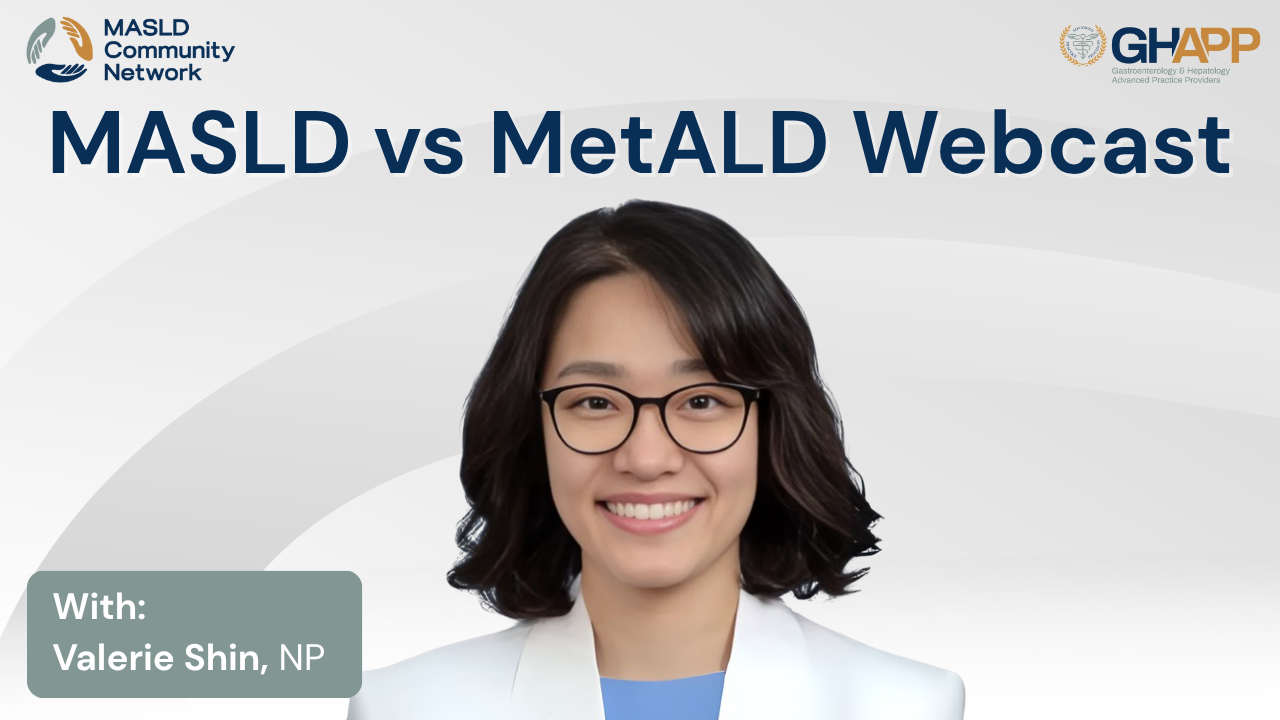
MASLD vs MetALD With Valerie Shin

Valerie Shin, NP from UCLA Health’s Pfleger Liver Institute, hosts a clear, practical overview of MASLD, MASH, and mixed-etiology MET-ALD for the GHAPP MASLD Community Network (sponsored by Madrigal). Through a common patient case, she explains how to recognize steatotic liver disease, why getting an accurate alcohol history matters, and how non-invasive tools (like FibroScan and alcohol biomarkers) help confirm what’s driving liver injury. You’ll hear straightforward guidance on counseling patients: heart-healthy/Mediterranean-style eating, sustainable weight loss, regular aerobic and resistance exercise, and complete alcohol cessation—plus when to consider specialty referral and ongoing surveillance. Perfect for APPs and GI clinicians seeking a simple, patient-centered approach to preventing progression from fatty liver to advanced disease.
Watch Now
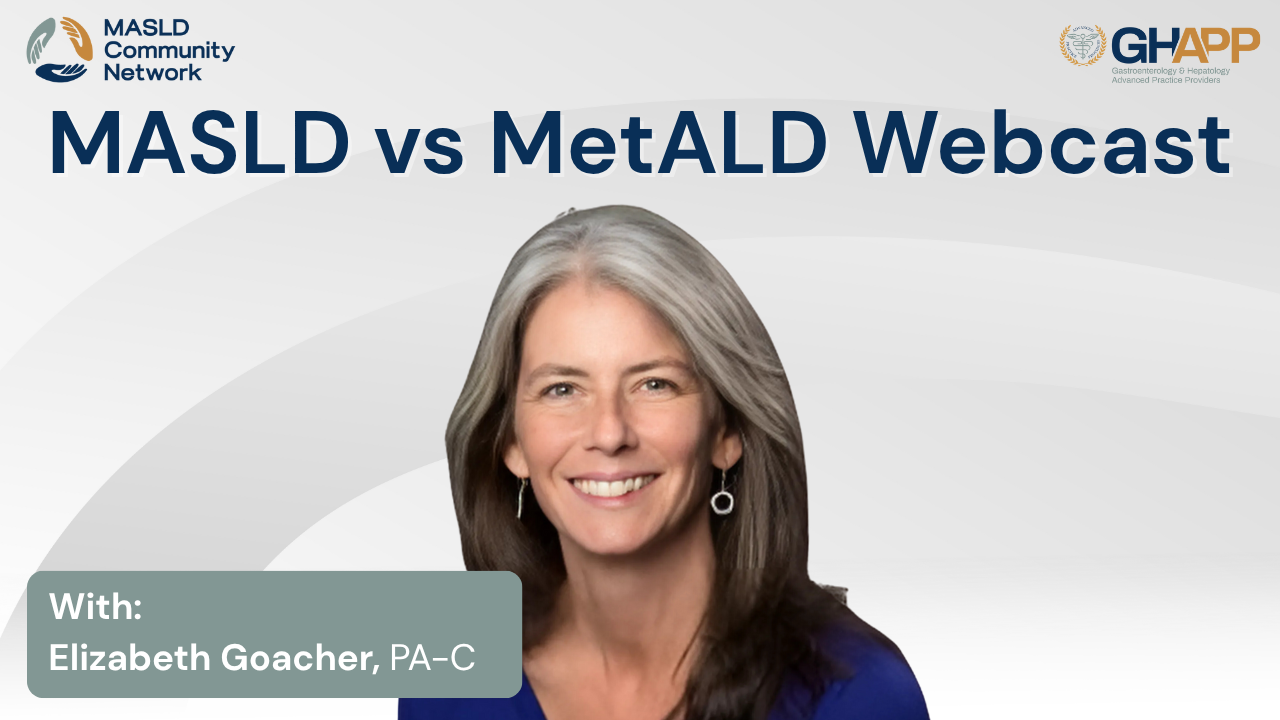
MASLD vs MetALD With Elizabeth Goacher

Elizabeth Goacher, PA-C, explains MASLD vs MetALD within the broader Steatotic Liver Disease (SLD) spectrum—and why separating metabolic dysfunction alone (MASLD) from metabolic dysfunction + alcohol exposure (MetALD) changes risk stratification and management. Through a real case, Elizabeth shows how to assess fibrosis risk, interpret CAP/Liver Stiffness, and recognize factors that can inflate stiffness. She reviews practical alcohol quantification, the limits of self-report, and when an objective biomarker like PEth can clarify true exposure—especially for patients with borderline metabolic criteria (e.g., isolated hypertension or hypertriglyceridemia). You’ll learn a stepwise approach for: confirming SLD etiology (exclude DILI, viral hepatitis, monogenic disease), choosing FIB-4, VCTE/FibroScan, or ELF for secondary assessment, deciding when to refer or biopsy for discordant results, and prioritizing therapy (alcohol reduction/cessation, cardiometabolic risk control, lifestyle intervention, and when targeted MASLD pharmacotherapy may be appropriate). She also discusses progression risk (MetALD accelerates vs MASLD), and thoughtful use of HCC surveillance in higher-risk patients. Perfect for APPs, GI/hepatology clinicians, and primary care optimizing real-world MASLD/MetALD care.
Watch Now
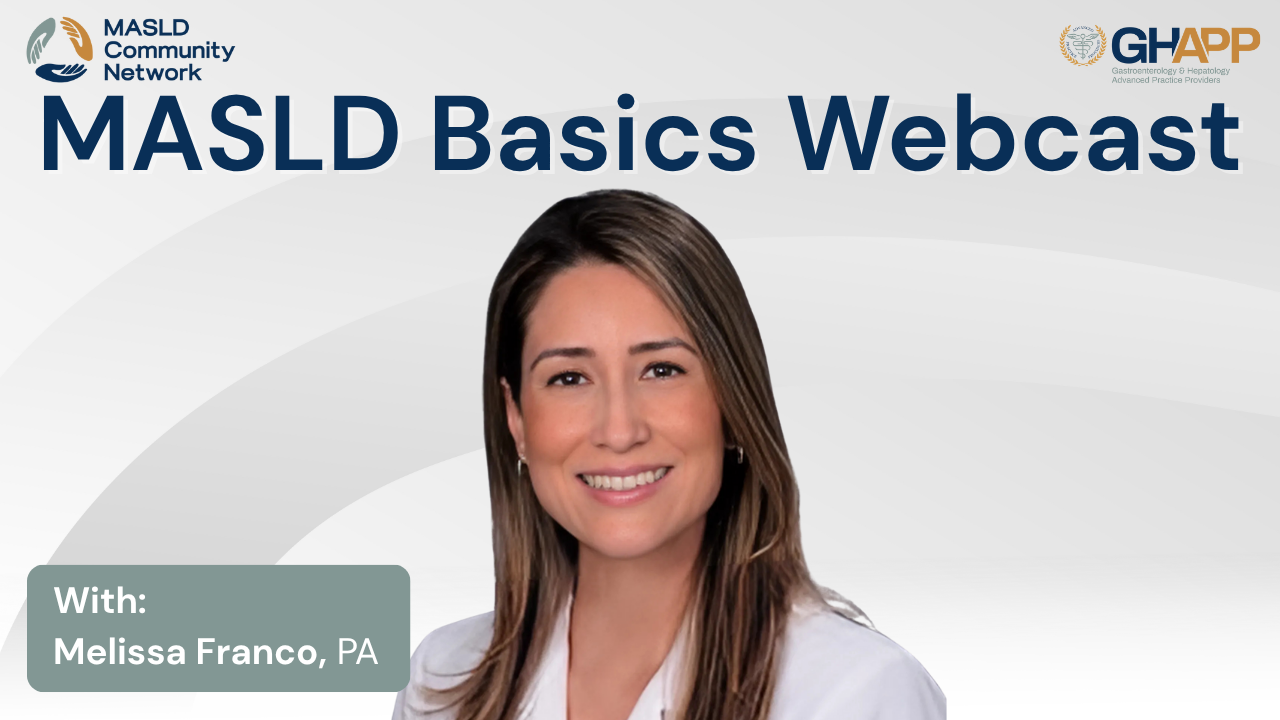
MASLD Basics With Melissa Franco

Join Melissa Franco, PA-C, from the University of Miami for a comprehensive review of MASLD (Metabolic Dysfunction-Associated Steatotic Liver Disease) and the 2023 nomenclature updates replacing NAFLD and NASH. Presented through the GHAPP MASLD Community Network and sponsored by Madrigal Pharmaceuticals, this session covers the spectrum of steatotic liver disease, including MASLD, MASH, MetALD, alcohol-related liver disease (ALD), and other causes of hepatic steatosis. Learn how to diagnose MASLD using imaging, cardiometabolic risk criteria, and how to exclude other causes like alcohol use, medications, and genetic disorders. Melissa explains how to risk stratify patients using FIB-4, FibroScan, and ELF testing, and when to consider referral to hepatology, especially for patients at intermediate or high risk for advanced fibrosis. The talk also explores global prevalence, natural history, disease progression to cirrhosis and HCC, and highlights the importance of identifying and managing patients with F2–F4 fibrosis, now classified as at-risk MASH. Through a real-world case study, viewers are guided on how to perform a thorough MASLD workup and assess patients for pharmacotherapy, lifestyle counseling, and surveillance protocols. Whether you are in primary care, GI, or endocrinology, this session is an essential resource for early diagnosis and comprehensive management of fatty liver disease in today’s clinical practice.
Watch Now
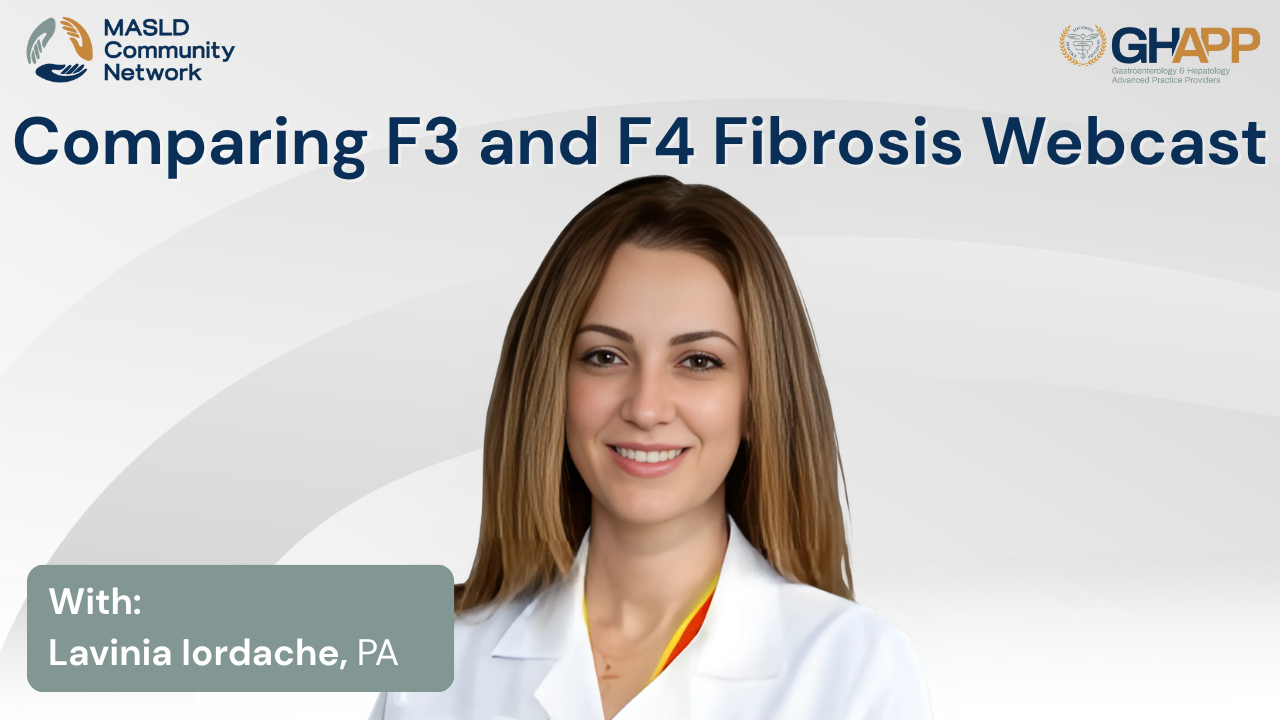
Comparing F3 and F4 Fibrosis With Lavinia Iordache

In this MASLD Community Network talk, Lavinia Iordache, PA, walks through a real-world case to show how to accurately identify advanced liver fibrosis and, critically, how to distinguish F3 vs F4—a difference that drives management, eligibility for resmetirom (Rezdiffra), and surveillance strategy. She demonstrates a stepwise use of non-invasive tests (NITs)—FIB-4, FibroScan/VCTE with kPa and CAP, ELF serum biomarkers, and when to add MRE or biopsy—plus how to handle discordant/indeterminate results. The session covers cardiometabolic risk factors, lab patterns, and practical monitoring tips, including HCC surveillance considerations (modality choice in obesity, AFP/AFP-L3) and portal-hypertension cues that trigger EGD for varices. You’ll leave with a clear algorithm to stage disease, personalize treatment, and avoid missing F3 candidates who may otherwise be excluded by FIB-4 alone.
Watch Now
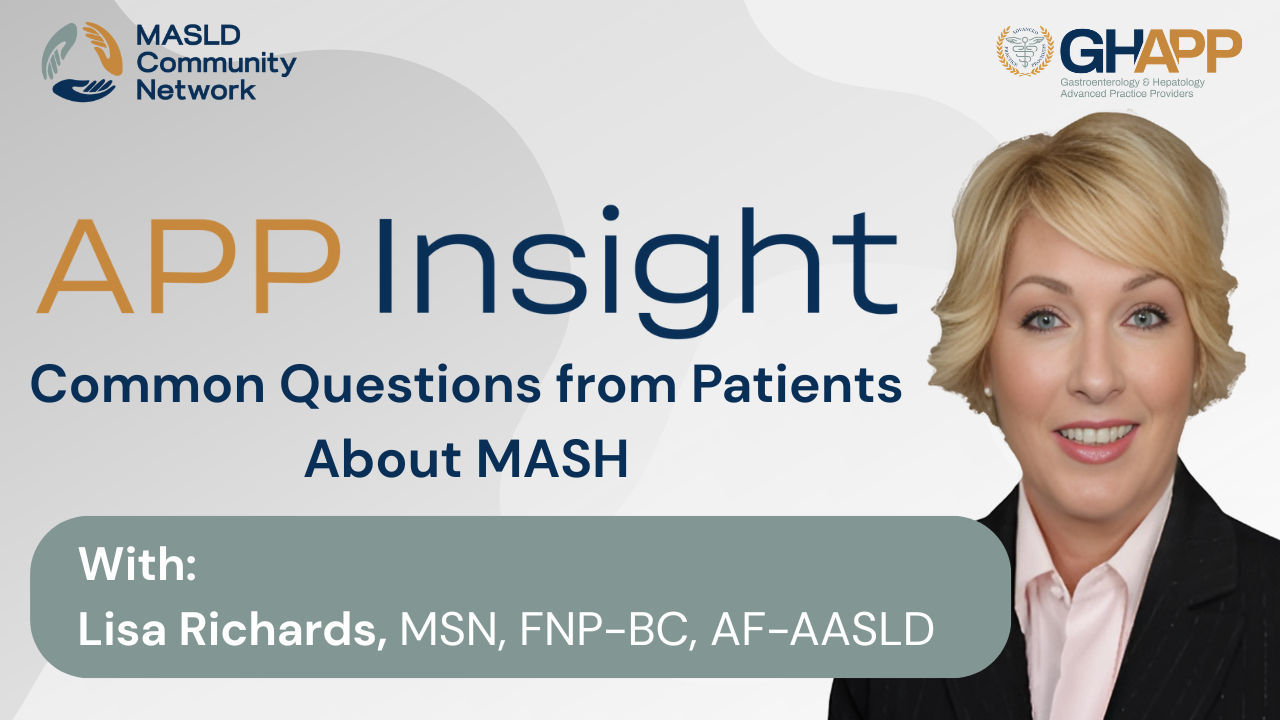
Common Questions From Patients About MASH

In this practical and patient-focused discussion from the GHAPP MASLD/MASH Community Network, we address some of the most frequently asked questions by patients newly diagnosed with MASLD (Metabolic dysfunction-associated steatotic liver disease). Many patients wonder how they can have liver disease if they don’t drink alcohol. This video explains the evolution from NAFLD to MASLD, emphasizing that MASLD is rooted in metabolic risk factors—not alcohol use—and commonly affects individuals with diabetes, obesity, and hypertension. Viewers will also learn about evidence-based lifestyle interventions, including the benefits of a hypocaloric diet, the recommended Mediterranean-style eating pattern, and 150 minutes of weekly physical activity. Finally, we tackle the question “Is MASLD curable?” with empowering guidance on how weight loss and exercise can help reverse liver damage and reduce liver fat. This is a must-watch for clinicians, care teams, and patients seeking clarity and confidence in managing this increasingly common liver disease.
Watch Now
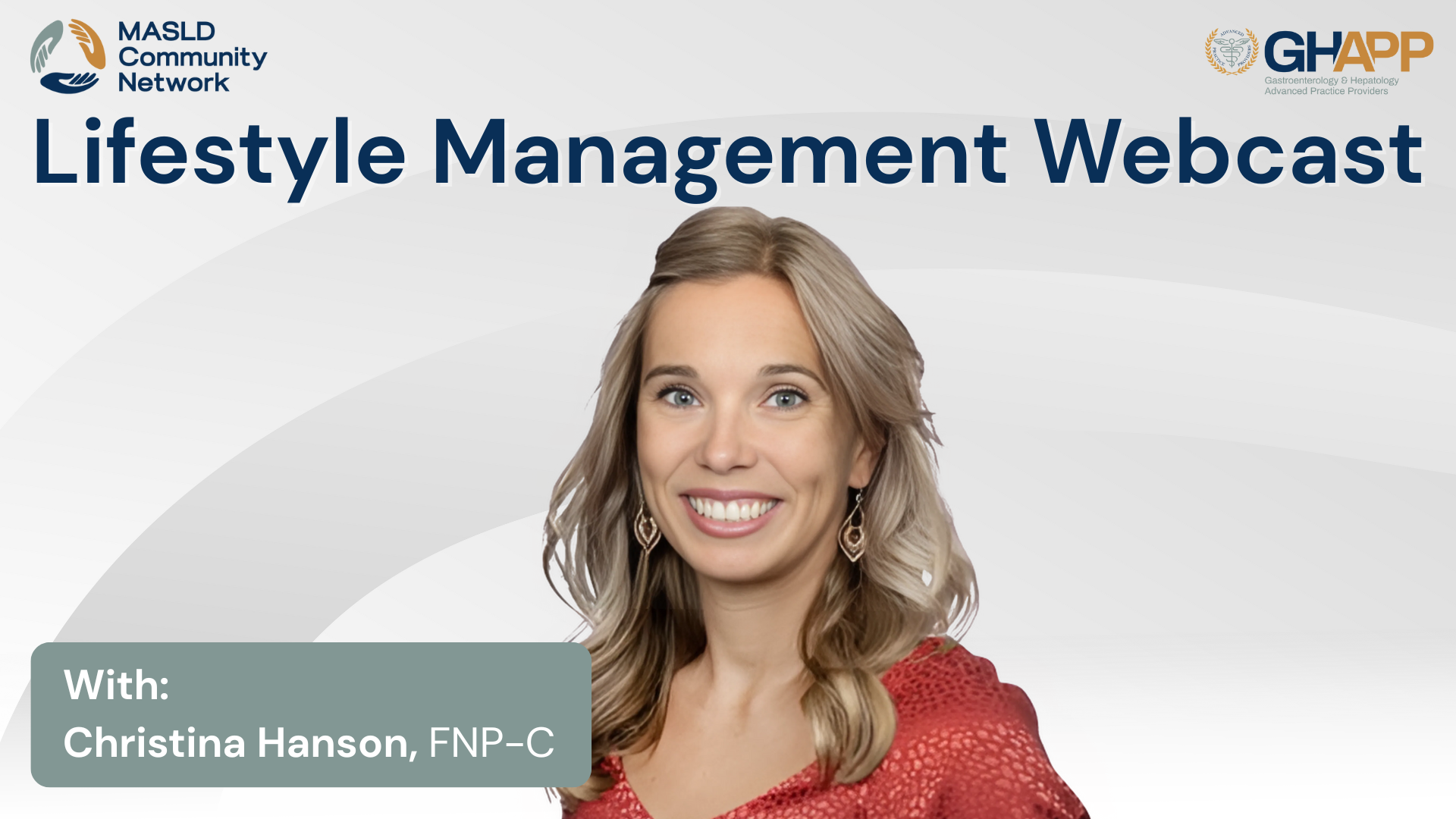
Lifestyle Management With Christina Hanson

Join Christina Hanson, NP from South Denver GI, for a practical and in-depth discussion on lifestyle management of MASLD (Metabolic Dysfunction-Associated Steatotic Liver Disease) and MASH (Metabolic Steatohepatitis). In this GHAPP MASLD/MASH Community Network session, Christina walks through the case of Albert, a 65-year-old patient with obesity, diabetes, and abnormal liver findings—representing a common clinical scenario in primary and specialty care. This session highlights how to apply non-invasive fibrosis assessment tools like FIB-4 and FibroScan, interpret metabolic risk factors, and differentiate patients based on fibrosis staging. Christina discusses how cultural dietary habits, access to care, and social determinants of health impact disease management, and emphasizes the importance of personalized counseling, accountability strategies, and gradual, sustainable changes to diet and exercise. The session also reviews the role of Resmetirom, the first FDA-approved treatment for MASH with F2-F3 fibrosis, and outlines guideline-recommended lifestyle interventions including the Mediterranean diet and combined aerobic/resistance exercise. Learn how to identify, stage, and manage patients with MASLD and MASH in a way that supports long-term adherence and improves liver-related outcomes. Educational support provided by Madrigal Pharmaceuticals.
Watch Now
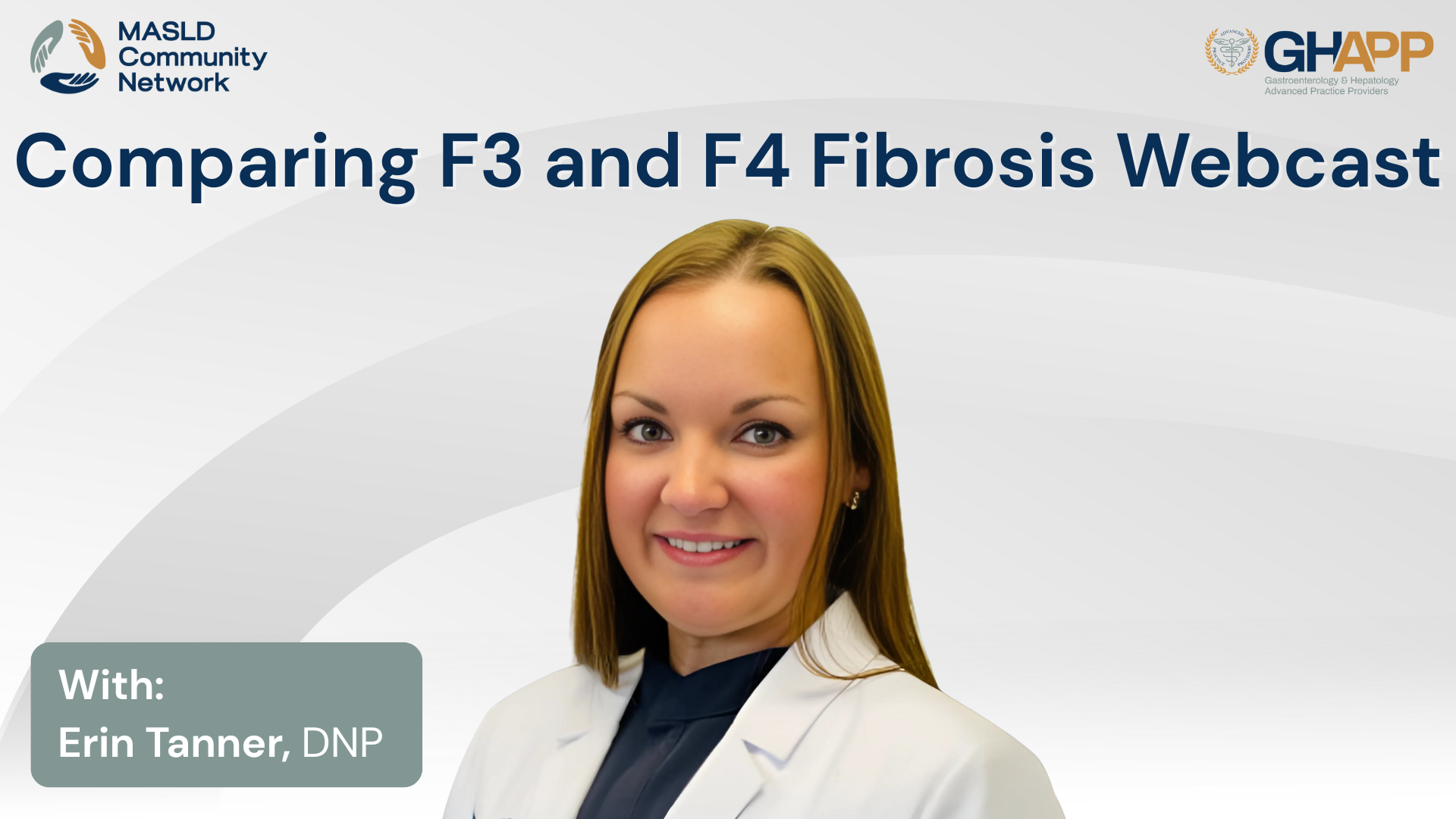
Comparing F3 and F4 Fibrosis With Erin Tanner

Join Erin Tanner, NP from Gastro Health in Birmingham, Alabama, for a practical and in-depth exploration of how to differentiate and manage patients with F3 versus F4 fibrosis in the setting of MASLD (Metabolic Dysfunction-Associated Steatotic Liver Disease) and MASH. This session, part of the MASLD & MASH Community Network, features two detailed case studies—Sam A and Sam B—who share identical comorbidities but diverge in fibrosis stage, illustrating how non-invasive testing (NITs) can guide diagnosis and treatment. Erin walks through the clinical application of tools like FIB-4, FibroScan (VCTE), ELF test, and CAP score, emphasizing the importance of interpreting lab and imaging results in context. The discussion covers key decision points, including when to initiate pharmacologic therapy like resmetirom (Rezdiffra), how to determine eligibility for HCC surveillance, and when to consider liver biopsy. She also addresses common challenges in community GI settings, such as incidental fatty liver findings, elevated ferritin levels, and the limitations of FIB-4 in older or diabetic patients. Whether you're in hepatology, gastroenterology, or primary care, this talk offers actionable insights on fibrosis staging, lifestyle counseling, and long-term monitoring in patients with MASLD and MASH.
Watch Now





 September 2025
September 2025 